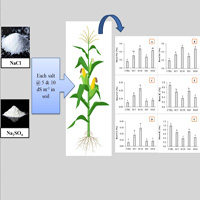Salinity types and level-based effects on the growth, physiology and nutrient contents of maize (Zea mays)

Accepted: 13 July 2019
HTML: 138
All claims expressed in this article are solely those of the authors and do not necessarily represent those of their affiliated organizations, or those of the publisher, the editors and the reviewers. Any product that may be evaluated in this article or claim that may be made by its manufacturer is not guaranteed or endorsed by the publisher.
Salinity is a devastating problem of arid and semi-arid climatic regions with uneven salt accumulation which hinders growth and development of crops. The deleterious effects of salinity mainly depend on level and source of salinity. We hypothesized that types of sodium salt (NaCl and Na2SO4) might cause variable toxicity in maize (Zea mays L.) plants. The objective of the present study was to compare the effect of different types of sodium salt (NaCl and Na2SO4), each at EC 5 and 10 dS m–1 on growth, physiology and nutrient contents of maize plant grown in earthen pots under wire house conditions. Results revealed toxic effects of salt stress on seed germination, root and shoot growth and biomass. Maize physiology in terms of sub-stomatal CO2 index, chlorophyll and relative water contents, photosynthetic and transpiration rate also reduced under salt stress. Among the types of salt and levels of salinity, NaCl applied at the rate of 10 dS m–1 caused the highest reduction in seed germination, growth and physiology due to high accumulation of Na and Cl ions whereas low in K ion in maize plant tissues. Based on the findings, we do conclude that NaCl applied at the rate of 10 dS m–1 has more negative impact on maize growth and nutrient acquisition than Na2SO4 at same level of salinity.
How to Cite
PAGEPress has chosen to apply the Creative Commons Attribution NonCommercial 4.0 International License (CC BY-NC 4.0) to all manuscripts to be published.

 https://doi.org/10.4081/ija.2019.1326
https://doi.org/10.4081/ija.2019.1326



